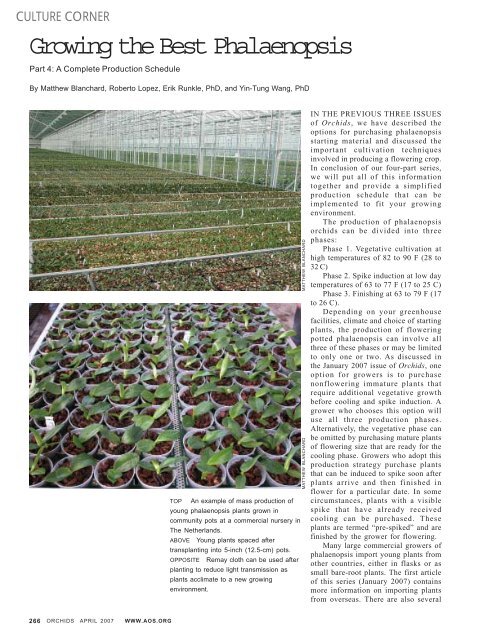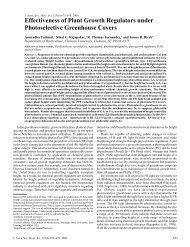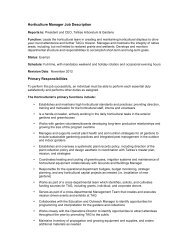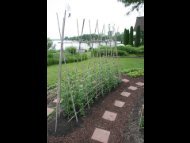Growing the best phalaenopsis, part 4 - Michigan State University
Growing the best phalaenopsis, part 4 - Michigan State University
Growing the best phalaenopsis, part 4 - Michigan State University
You also want an ePaper? Increase the reach of your titles
YUMPU automatically turns print PDFs into web optimized ePapers that Google loves.
CULTURE CORNER<strong>Growing</strong> <strong>the</strong> Best PhalaenopsisPart 4: A Complete Production ScheduleBy Mat<strong>the</strong>w Blanchard, Roberto Lopez, Erik Runkle, PhD, and Yin-Tung Wang, PhDTOP An example of mass production ofyoung <strong>phalaenopsis</strong> plants grown incommunity pots at a commercial nursery inThe Ne<strong>the</strong>rlands.ABOVE Young plants spaced aftertransplanting into 5-inch (12.5-cm) pots.OPPOSITE Remay cloth can be used afterplanting to reduce light transmission asplants acclimate to a new growingenvironment.MATTHEW BLANCHARDMATTHEW BLANCHARDIN THE PREVIOUS THREE ISSUESof Orchids, we have described <strong>the</strong>options for purchasing <strong>phalaenopsis</strong>starting material and discussed <strong>the</strong>important cultivation techniquesinvolved in producing a flowering crop.In conclusion of our four-<strong>part</strong> series,we will put all of this informationtoge<strong>the</strong>r and provide a simplifiedproduction schedule that can beimplemented to fit your growingenvironment.The production of <strong>phalaenopsis</strong>orchids can be divided into threephases:Phase 1. Vegetative cultivation athigh temperatures of 82 to 90 F (28 to32 C)Phase 2. Spike induction at low daytemperatures of 63 to 77 F (17 to 25 C)Phase 3. Finishing at 63 to 79 F (17to 26 C).Depending on your greenhousefacilities, climate and choice of startingplants, <strong>the</strong> production of floweringpotted <strong>phalaenopsis</strong> can involve allthree of <strong>the</strong>se phases or may be limitedto only one or two. As discussed in<strong>the</strong> January 2007 issue of Orchids, oneoption for growers is to purchasenonflowering immature plants thatrequire additional vegetative growthbefore cooling and spike induction. Agrower who chooses this option willuse all three production phases.Alternatively, <strong>the</strong> vegetative phase canbe omitted by purchasing mature plantsof flowering size that are ready for <strong>the</strong>cooling phase. Growers who adopt thisproduction strategy purchase plantsthat can be induced to spike soon afterplants arrive and <strong>the</strong>n finished inflower for a <strong>part</strong>icular date. In somecircumstances, plants with a visiblespike that have already receivedcooling can be purchased. Theseplants are termed “pre-spiked” and arefinished by <strong>the</strong> grower for flowering.Many large commercial growers of<strong>phalaenopsis</strong> import young plants fromo<strong>the</strong>r countries, ei<strong>the</strong>r in flasks or assmall bare-root plants. The first articleof this series (January 2007) containsmore information on importing plantsfrom overseas. There are also several266 ORCHIDS APRIL 2007 WWW.AOS.ORG
MATTHEW BLANCHARDdomestic producers of young plantswho can provide actively growingplants in media.Since May 2005, nurseries in <strong>the</strong>United <strong>State</strong>s have been permitted toimport potted <strong>phalaenopsis</strong> of all sizesgrown in approved media from Taiwan.Although <strong>the</strong>se plants were originallyshipped to <strong>the</strong> United <strong>State</strong>s byairfreight, due to high transportationcosts most plants are now imported bysea freight. During transport by sea,potted <strong>phalaenopsis</strong> are packed in airconditionedcargo containers andshipped in complete darkness for threeto four weeks. When done properly,plant loss is less than five percent andmature plants can be immediatelyinduced to flower upon arrival at <strong>the</strong>destination greenhouse. Research iscurrently being performed at TexasA&M <strong>University</strong> to learn how plantquality can be fur<strong>the</strong>r improved.With <strong>the</strong>se options for purchasingplant material in mind, let’s now discussa simple schedule for producing a cropof flowering <strong>phalaenopsis</strong>.PHASE 1: VEGETATIVE GROWTHA grower who purchases youngimmature plants will begin productionof <strong>phalaenopsis</strong> with vegetativecultivation. For <strong>the</strong> large-floweredhybrids and clones, this plant materialgenerally will not flower uniformly untilplants have an average leafspan of 10inches (25 cm) or greater. Therefore,plants are grown at high temperaturesto promote leaf development and inhibitflowering.Plants purchased in flasks are oftentransplanted into square or rectangularcommunity pots, with about 40 or 50plants per tray. After approximately 20to 25 weeks of growth at hightemperatures, plants are <strong>the</strong>n transplantedinto individual containers for<strong>the</strong> next stage of vegetative growth.Plant material with an average leafspanof 8 inches (20 cm) is oftentransplanted into 5-inch (12-cm) pots.Spacing depends on plant size andgrower preference, but early in <strong>the</strong>production phase, plants can be spacedpot-to-pot.Following transplanting, severalirrigations may be necessary tosufficiently moisten <strong>the</strong> substrate,depending on <strong>the</strong> environmentalconditions and medium composition.Due to <strong>the</strong> low water-holding capacityof fresh bark, newly transplantedmaterial will need to be frequentlychecked for watering until <strong>the</strong> mediumWWW.AOS.ORG APRIL 2007 ORCHIDS 267
CULTURE CORNERbegins to hold more moisture.Alternatively, <strong>the</strong> addition of asurfactant (or a few drops of dishwashingliquid) to <strong>the</strong> water can reduce<strong>the</strong> surface tension of <strong>the</strong> media andimprove water absorption. Media withhigh water-holding capacities need lessfrequent watering. If bare-root plantsare planted in moist sphagnum moss,no watering is needed until <strong>the</strong> mosshas become nearly dry. Light sprinklingdaily also helps plant recovery during<strong>the</strong> first few weeks after transplant.Some growers place a thin layer ofpolyethylene fabric (e.g., Remay cloth)over benches for one to two weeks afterplanting bare-root plants to create diffuselight levels less than 1,000 foot-candles(200 µmol•m -2 •s -1 ) and to increasehumidity. This strategy helps tominimize plant stress and reduce plantloss after planting.Young plants are grown at hightemperatures in <strong>the</strong> range of 82 to 90 F(28 to 32 C), at least during <strong>the</strong> day, topromote vegetative growth and inhibitflowering. If environmental conditionsare favorable, plants with a leafspan of4 to 5 inches (10 to 12.5 cm) requireapproximately 22 to 27 weeks to reachflowering size. This duration dependson temperature, <strong>the</strong> initial leafspan,fertility and <strong>the</strong> size desired before <strong>the</strong>induction of flowering. On average, anew leaf will emerge every six weeksand will reach maturity after 10 weekswhen grown at <strong>the</strong>se high temperatures.As <strong>the</strong> growing temperature decreases,<strong>the</strong> rate of leaf development slows.When importing mature bare-root plantMATTHEW BLANCHARDMATTHEW BLANCHARDmaterial from overseas, providing fourto six weeks of growth in a warmenvironment after planting will bebeneficial for rooting and subsequentflowering.Growers should monitor light levelswith a light meter and adjust shadingto provide between 500 and 1,500 footcandles(100 to 300 µmol•m -2 •s -1 ) ofdiffused light at canopy level. Plantsshould be spaced as necessary tominimize leaf overlap and allow foradequate air circulation. Duringspacing, it is also a good idea to sortplants according to leafspan. Plantswith a small leafspan will requireadditional time before <strong>the</strong> onset of <strong>the</strong>cooling phase.PHASE 2: COOLING When plantshave five to seven leaves and aminimum leafspan of 10 inches (25 cm),<strong>the</strong> cooling phase can begin to inducespiking. A grower that purchasesmature potted plants may begin withthis phase of production. Plants canbe cooled at temperatures in <strong>the</strong> rangeof 63 to 77 F (17 to 25 C) for approximatelyfour to six weeks. At <strong>the</strong> lowerend of this temperature range, plantsmay produce two or more spikes. Inmost <strong>phalaenopsis</strong> hybrids, a spike (<strong>the</strong>potentially flowering stem) will usuallybecome visible after three or four weeksof cooling. However, longer durationsmay be required for some hybrids orwhen plant material is smaller.Cooling may take place in <strong>the</strong> samegreenhouse section as <strong>the</strong> vegetativephase if all plants in that section are tobe induced into flower. When only aportion of plants are to be induced intoflower, a separate greenhouse sectionis needed for cooling. Providing lowtemperatures to young plants caninduce variable premature spiking andslow down vegetative growth, both ofwhich are undesirable.PHASE 3: FINISHING The finishingphase describes <strong>the</strong> period fromspike emergence through spikedevelopment and flowering. Aftercooling, plants may ei<strong>the</strong>r be transferredto a separate finishing area forflowering or remain in <strong>the</strong> samegreenhouse section used during <strong>the</strong>cooling phase. Plant spacing can be <strong>the</strong>same as during <strong>the</strong> cooling phase.Temperatures in <strong>the</strong> range of 63 to 79 F(17 to 26 C) are used during finishing.Since flower bud initiation begins when<strong>the</strong> spike has reached about 2 inches(5 cm) in length, maintaining temperaturesbetween 63 and 68 F (17 to 20268 ORCHIDS APRIL 2007 WWW.AOS.ORG
C) until <strong>the</strong> spikes are 12 inches (30 cm)or longer can increase <strong>the</strong> number offlowers. Some hybrids grown at a coolertemperature may also have increasedlateral branching of <strong>the</strong> inflorescence.It is important to avoid extendedexposure to temperatures above 79 F(26 C) during this final phase. Hightemperature can reduce flower budnumber and flower size, and flowerbuds may abort. In addition, prolongedexposure to high temperatures caninduce a vegetative air plantlet to formon <strong>the</strong> spike (referred to as a “keiki”)ra<strong>the</strong>r than flower buds.Following spike emergence, <strong>the</strong> rateof development toward flowering iscontrolled by <strong>the</strong> average daily temperature.For example, in researchconducted at <strong>Michigan</strong> <strong>State</strong> <strong>University</strong>,as <strong>the</strong> average daily temperatureincreased from 57 to 76 F (14 to 26 C),<strong>the</strong> average time from spike emergenceto flowering decreased from 217 to 54days (Table 1). This time variessomewhat by cultivar, with someflowering earlier and some a few weekslater. Based on this information andgrower experience, <strong>the</strong> greenhousetemperature can be raised or loweredto finish a <strong>phalaenopsis</strong> crop for adesired flowering date.An important component of <strong>the</strong>finishing phase involves staking andpreparing <strong>phalaenopsis</strong> for an orchidshow or sale. Properly staking <strong>the</strong>inflorescence will affect how <strong>the</strong> plantis presented at a show or sale, thusimproving consumer appeal. Inaddition, staking will also minimizeplant damage during packaging andtransport. Plants should be staked nolater than when <strong>the</strong> lowest flower budon an inflorescence has reached <strong>the</strong>size of a marble. The stick (bamboo oro<strong>the</strong>r materials) used for stakingshould not be taller than <strong>the</strong> lowestflower bud and can be attached to <strong>the</strong>inflorescence using clips or ties. At <strong>the</strong>time of staking, plants are often sortedbased on a predetermined qualitygrading scale (i.e., number of spikes andflowers or spike length).POST-HARVEST When plantshave at least one or two open flowers,<strong>the</strong>y are ready for display or sale andcan be packaged for transport. Thepreparation of plants for shipping andsales display is a labor-intensiveprocess that can involve many tasks.Phalaenopsis leaves are sometimescleaned and plants are placed intodecorative ceramic or terracotta potsROBERTO LOPEZERIK RUNKLEOPPOSITE TOP Staking plants is animportant step during <strong>the</strong> finishing phase.Plants should be staked no later than when<strong>the</strong> lowest flower bud on an inflorescencehas reached <strong>the</strong> size of a marble.OPPOSITE ABOVE Mature plants during <strong>the</strong>cooling phase with spike initiation.TOP Phalaenopsis placed into decorativeterracotta pots and ready for shipping to aretail store.ABOVE Three <strong>phalaenopsis</strong> plantscombined into a decorative container inJapan.Table 1. The effect of average daily temperature on <strong>the</strong> average time from visible spike toflower in several <strong>phalaenopsis</strong> hybrids grown at <strong>Michigan</strong> <strong>State</strong> <strong>University</strong>.Temperature F (C)Time from Visible Spike to Flower (Days)57 (14) 21763 (17) 14068 (20) 9773 (23) 7176 (26) 54WWW.AOS.ORG APRIL 2007 ORCHIDS 269
CULTURE CORNERMATTHEW BLANCHARDwith sphagnum moss on <strong>the</strong> surface of<strong>the</strong> growing medium. A label with careinformation is often affixed to <strong>the</strong>support stick and leaf shine may beapplied to <strong>the</strong> foliage before <strong>the</strong> plantis placed into a protective sleeve.Potted <strong>phalaenopsis</strong> are perceived byconsumers as elegant plants with highornamental value. As a result, all of<strong>the</strong>se steps can add value to <strong>the</strong>product and influence how <strong>the</strong> plant ispresented to <strong>the</strong> consumer.Flowers of all orchids, including<strong>phalaenopsis</strong>, are extremely sensitiveto low concentrations of ethylene, anodorless, colorless gas released byripening fruits and flowers, cigaretteand wood smoke and exhaust from gasheaters and combustion engines.Ethylene concentrations as low as 0.1<strong>part</strong>s per million will cause all<strong>phalaenopsis</strong> flowers and buds to falloff within three days. To avoid ethylenedamage, growers should preventexposing plants to external sources ofethylene and also provide adequateventilation in <strong>the</strong> greenhouse. Researchat Texas A&M <strong>University</strong> showed thattreating flowering <strong>phalaenopsis</strong> withanti-ethylene products such as 1-methylcyclopropene (1-MCP, or Ethyl-Bloc) at 0.2 <strong>part</strong>s per million for sixhours at 77 F (25 C) protects flowersfrom ethylene concentrations as highas 10 <strong>part</strong>s per million. However, <strong>the</strong>duration of protection from 1-MCP isshort (seven days at 77 F or 25 C) and<strong>the</strong> duration of protection declines astemperature increases. The use of 1-MCP or EthylBloc is generally limitedto commercial greenhouse growers.Hobbyists and growers have manyoptions to produce flowering <strong>phalaenopsis</strong>orchids. Immature plants willcost less than mature ones, but willrequire a longer production time andadditional expenses. In temperateclimates, one of <strong>the</strong> largest productionexpenses is <strong>the</strong> energy for heating agreenhouse to promote vegetativegrowth. Growers who wish to reduceproduction time and heating costs maychoose to purchase more expensiveplant material that is of flowering sizeand can be immediately forced toflower. This option would avoid <strong>the</strong>need to grow plants at a hightemperature to promote additionalvegetative growth.A simplified schedule for <strong>the</strong>production of <strong>phalaenopsis</strong> in 5-inch(12.5-cm) pots is provided in Table 2.From this, and with <strong>the</strong> informationprovided in our four-<strong>part</strong> series, youcan develop a production schedule tofit your greenhouse conditions andproduce a crop of flowering potted<strong>phalaenopsis</strong> orchids. Although thisarticle has focused on environmentalcontrol of growth and flowering,cultural factors such as watering,fertility, pest and disease control andselection of an appropriate medium arealso highly important for producing asuccessful and profitable crop.AcknowlegmentsWe would like to thank <strong>the</strong> Fred C.Gloeckner Foundation, <strong>the</strong> American OrchidSociety, Matsui Nursery, Taiwan SugarCorporation, Project GREEEN and privategreenhouse companies that support orchidresearch.(This article was adapted from a seriespublished in Greenhouse Grower magazine.)270 ORCHIDS APRIL 2007 WWW.AOS.ORG
MATTHEW BLANCHARDMat<strong>the</strong>w Blanchard and Roberto“RoLo” Lopez are PhD graduateassistants at <strong>Michigan</strong> <strong>State</strong> <strong>University</strong>.Erik Runkle, PhD, is assistant professorand floriculture extension specialist at<strong>Michigan</strong> <strong>State</strong> <strong>University</strong> (e-mailrunkleer@msu.edu). Yin-Tung Wang,PhD, is professor of floriculture atTexas A&M <strong>University</strong> (e-mail ytwang@tamu.edu).OPPOSITE Phalaenopsis carefuly wrappedfor transit.ABOVE Phalaenopsis prepared for displayand sale at Nagoya Orchid Gardens inNagoya, Japan.Table 2. A simplified schedule for <strong>the</strong> production of flowering potted <strong>phalaenopsis</strong> orchids in 5-inch (12.5-cm) pots.Production PhaseUnitsVegetativeGrowthC oolingFinishing (to First Flower)DurationWeeksUntil PlantMaturity4 to 6201410TemperatureF 82to 9063to 77636873C 28to 3217to 25172023LightIntensityFoot-Candles500to 1,5001,000to 1,5001,000 to 1,5002µ mol•m-• s-100 to 30 01 200to 300200 to 300WWW.AOS.ORG APRIL 2007 ORCHIDS 271
















